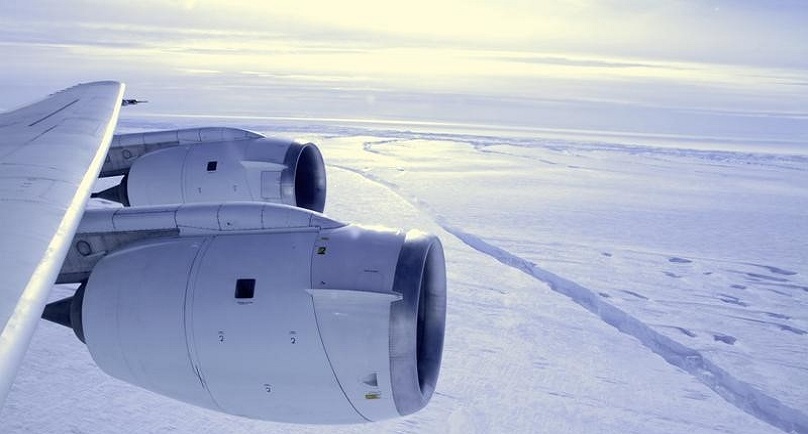Image: NASA’s DC-8 flies across a crack, 18 miles (29 km) in length, forming across the Pine Island Glacier ice shelf in this October 26, 2011 handout photograph. REUTERS/NASA/GSFC/Jefferson Beck/Handout
![]()
By Alister Doyle
OSLO (Reuters) – Burning all the world’s fossil fuel reserves could thaw the entire Antarctic ice sheet and push up world sea levels by more than 50 meters (160 feet), over thousands of years, an international study said on Friday.
Such a melt, also eliminating the far smaller ice sheet on Greenland, is a worst case of climate change that would inundate cities from New York to Shanghai and change maps of the world with much of the Netherlands, Bangladesh or Florida under water.
“Burning the currently attainable fossil fuel resources is sufficient to eliminate the (Antarctic) ice sheet,” the scientists wrote in the journal Science Advances. Antarctica contains ice equivalent to 58 meters of sea level rise.
Even current emissions from oil, coal and natural gas could make the West Antarctic ice sheet unstable, they said, if continued for 60-80 years. That would account for just 6-8 percent of fossil fuel reserves.
“What we are doing right now might change the face of the Earth for millennia to come,” lead author Ricarda Winkelmann of the Potsdam Institute for Climate Impact Research in Germany told Reuters.
France will host a Nov. 30-Dec. 11 summit of almost 200 nations to seek ways to combat climate change, partly by shifting from fossil fuels to renewable energies.
Last week, Christiana Figueres, the U.N.’s climate chief, told Reuters that two-thirds or more of fossil fuel reserves would have to stay in the ground to limit warming to a U.N. ceiling of 2 degrees Celsius (3.6 Fahrenheit) above pre-industrial times to avert floods, droughts and heatwaves.
Friday’s study estimated that curbs on emissions to limit warming to 2C could restrict long-term sea level rise to a few meters. Seas have risen by about 20 cm (8 inches) since 1900.
“If we don’t stop dumping our waste carbon dioxide into the sky, land that is now home to more than a billion people will one day be under water,” Ken Caldeira, a co-author at the U.S. Carnegie Institution, said in a statement.
A thaw of much of Antarctica is remote even with high rates of warming – temperatures at the South Pole were a bone-chilling minus 71C (minus 95F) on Friday, according to the U.S. National Weather Service.
But Winkelmann said a flow of ice towards the ocean could eventually thin the 2,700-metre (8,860-feet) thick ice at the Pole, exposing the surface to warmer temperatures.
(Study available at http://advances.sciencemag.org/content/1/8/e1500589; Reporting by Alister Doyle; Editing by Dale Hudson)
Copyright 2015 Thomson Reuters. Click for Restrictions.


